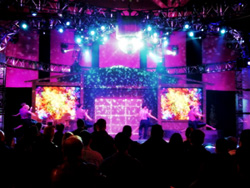|
Some event organizers may confuse the lighting designer with the lighting vendor. It is an easy mistake to make; yet it could be fatal to the production.
In much the same way that a quarry supplies stone, the lighting vendor supplies the lamps that are used in lighting the event. But as stone must later be formed into slabs and incorporated into buildings, so must the lights be organized and choreographed. Their formation must be designed and they must be programmed to move or change colour according to the wishes of the event's directors or the showcased artist. While a lighting vendor may have specialized knowledge of the lighting hardware, it may have no knowledge of the artistic or conceptual requirements of an event's directors; it may have no creative experience and no knowledge of available artistic alternatives. Rather, these areas are within the expertise of the lighting designer.
While as little as 100 years ago stage lighting was a matter of simple illumination (light the oil lamp and away you go), things have changed.
 It has been said that today, the lighting designer must not only be an artist, but a master of science, history, psychology, communications, politics and sometimes even telepathy. In its simplest form the lighting designer is an interpreter, understanding the event’s specifications out of meetings and discussions with the project director and other members of the creative team (such as the set designer or a showcased artist). It is the designer’s task to learn exactly what the creative team wishes to accomplish. Will the lighting simply illuminate the scene, or become a character in its own right? Will it be a subtle backdrop for the band or an incredible ‘in your face’ visual display? Will it be a combination of all of these ideas, or none, something totally different? The possibilities are infinite. It has been said that today, the lighting designer must not only be an artist, but a master of science, history, psychology, communications, politics and sometimes even telepathy. In its simplest form the lighting designer is an interpreter, understanding the event’s specifications out of meetings and discussions with the project director and other members of the creative team (such as the set designer or a showcased artist). It is the designer’s task to learn exactly what the creative team wishes to accomplish. Will the lighting simply illuminate the scene, or become a character in its own right? Will it be a subtle backdrop for the band or an incredible ‘in your face’ visual display? Will it be a combination of all of these ideas, or none, something totally different? The possibilities are infinite.
Next, the designer should draft a lighting plot, the technical document that depicts exactly where in the venue the lighting fixtures will be placed and what type of fixtures they will be. In addition to the lighting plot equipment lists, channel sheets, circuiting diagrams and other related documents should be drafted (of course, Hungry at Dawn does all of these).
Once the initial plot is drafted, we coordinate any additional lighting features, including adding any required lighting for additional performers, speakers, scenic elements or events. This involves careful consultation with the production team and with any additional creative directors. The lights are then ordered from a lighting vendor, and positioned in the venue according to the lighting plot.
Event producers can easily spend millions of dollars on scenery, costumes, and performers and have it all wasted because of ‘bad’ lighting.
|

